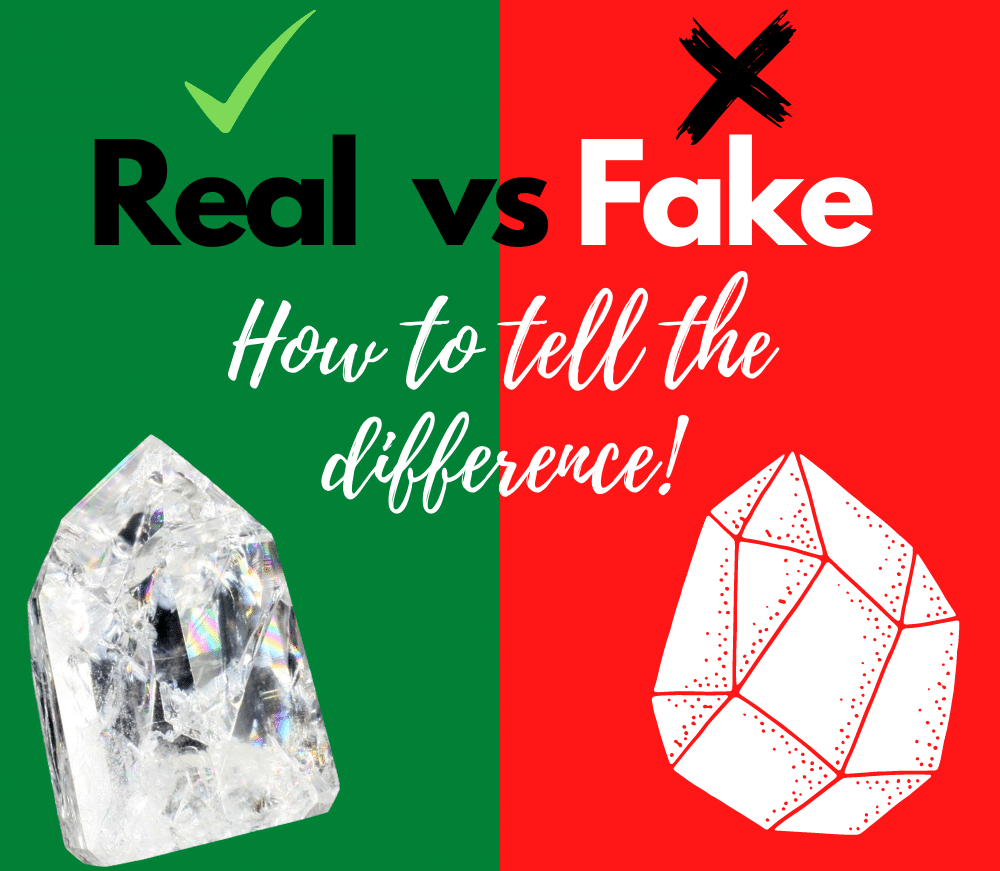One of the most common questions I get is, “How Can I Tell if a Crystal is Real?”
Vendors sometimes sell crystals that are not natural, and at first glance, you may not notice that the crystal you purchased is not real!
To learn how to differentiate between a real, natural crystal and one that has been altered or is made from synthetic materials, read on to spot the differences.
Signs a Crystal is Real
Real crystals that come naturally from the earth are commonly sought after for their healing properties.
These crystals vibrate at different frequencies to help us shift our energy for physical, spiritual, and emotional wellness.
Real crystals often have imperfections and asymmetrical patterns.
A crystal NOT from the earth often has perfectly symmetric patterns and markings.
Natural crystals usually have a harder texture or roughness to them as opposed to fake crystals.
Crystal toughness is rated on the Mohs hardness scale, and while some are on the softer side, most crystals from the earth are tough enough to scratch a piece of glass.
Real or fake crystals are based on price points.
Crystals that are hard to find or of high quality are higher in price, whereas inauthentic crystals are sold at cheaper rates.
Natural crystals usually have simple names like Quartz, Rose Quartz, Citrine, or Amethyst.
A crystal with an unusual or gimmicky name is usually not from the earth (such as “Unicorn Stone”).
Tumbled or polished natural crystals are still authentic and do not detract from any of the crystal’s healing properties.
The same applies to real crystals cut into specific shapes.
Signs a Crystal is Fake
Some crystals are artificially dyed to enhance the crystal’s color or to be passed off as a different stone.
Sliced Agate is often dyed bright, vibrant shades and sold as a natural crystal.
While the piece of Agate itself is real, the manipulated coloring is fake and not of the earth.
Magentas, violets, and varying shades of bright blues are examples of dyed Agate crystals.
Furthermore, White Howlite is often dyed blue to pass as a genuine piece of Turquoise crystal.
You can tell by the unnatural deep coloring in the stone’s cracks and the lower price point.
Marbles that have been designed to present as real crystals are easy to spot by the air bubbles in each piece.
Natural crystals will not have air bubbles but rather various imperfections.
Some glass crystals, such as Opalite, are still popular for their appearance and unique energy despite not being natural crystals.
Goldstone is another man-made crystal that is popular, as the stones contain flecks of healing copper for energetic healing.
Aura Quartz is a man-made crystal that still contains healing properties.
Pieces of Quartz are heated in a vacuum and fused with various metals, such as gold, to create unique crystal combinations.
Ultimately, it is important to trust the store or online shop you are purchasing your crystals from to know you are receiving real and natural crystals.
Ask questions about where the crystals come from, and use your instinct to see if you feel aligned with their source.
Cards and Crystals offers a carefully vetted healing crystals selection from trusted vendors.
Popular Crystals That May Be Fake
1. Amethyst
Amethyst that has been altered or is fake will be a saturated shade of vibrant purple. Typically, real Amethyst is light to deep purple with uneven tones throughout.
2. Rose Quartz
Rose Quartz should be a pale to darker pink hue, not Fuschia or other unnatural shades of pink.
Vendors may sell fake pieces that have been dyed to pass off as natural Rose Quartz.
3. Clear Quartz
Clear Quartz is sometimes swapped for pieces of clear glass.
Notice the weight of the stone – it should be heavier and not perfectly clear if it is a real piece of Clear Quartz.
4. Citrine
Citrine is naturally a lighter shade of lemon yellow but not as common to find.
Most pieces of Citrine are formed by heat treating Amethyst to obtain that deep orange hue.
5. Turquoise
Turquoise is a rare stone to come across, so if the piece you are considering is flat in color and tends to resemble Howlite, then chances are you have found a fake crystal.
Final Thoughts
Crystals that are naturally from the earth make for great healing tools.
You can still benefit from crystals that have been dyed, heat treated, or manmade, as long as you are aware that the crystal is not a natural stone.
Notice each crystal you are considering for purchase to make sure the stone is authentic and meets your satisfaction.



